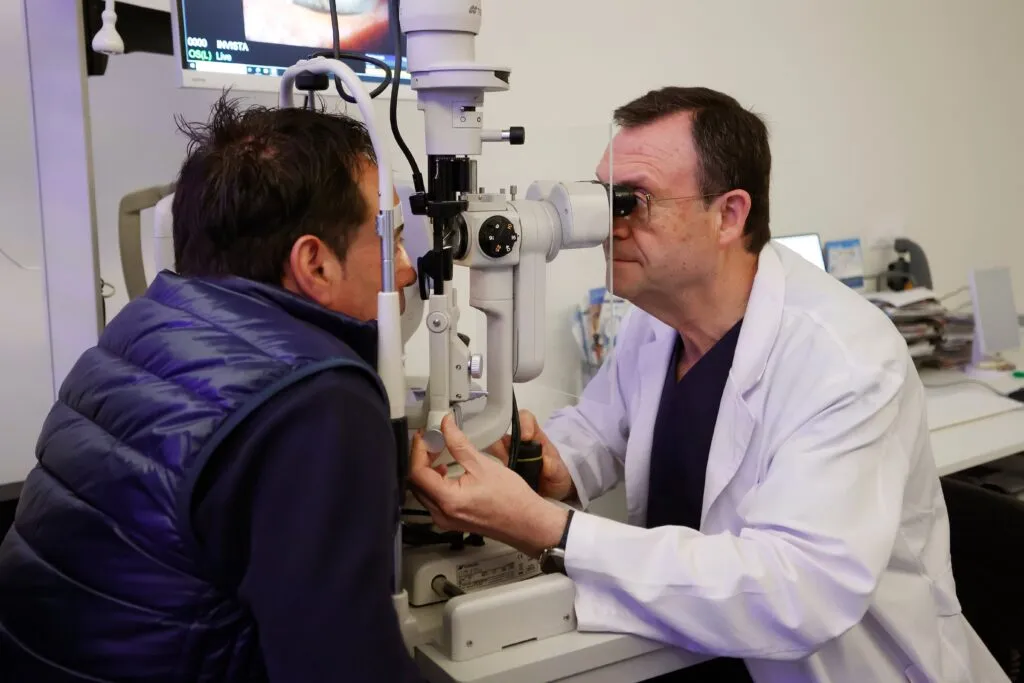
Accommodative spasm, a new eye risk due to screen overuse
The constant effort to focus on close objects can initially lead to “false myopia”
If excessive accommodation persists, the eye may elongate irreversibly, resulting in true myopia, an increasingly common phenomenon, especially among children and adolescents
The intensive use of mobile phones, computers, and tablets forces our eyes to maintain a constant effort, preventing them from resting properly. Today’s lifestyle, characterized by screen overuse from increasingly younger ages, is giving rise to a phenomenon known as “accommodative spasm”, a visual disorder that, if not detected and addressed in time, could seriously impact eye health in the coming years.
A problem that increases the risk of myopia
Accommodative spasm occurs when the eye is subjected to excessive accommodation while focusing on near objects for extended periods without rest, leading to symptoms such as blurred vision, eye strain, and headaches. Although this condition may seem temporary, Dr. Luis Valentín-Gamazo, an ophthalmologist at Miranza, warns that “this constant effort can alter the shape of the eye and promote the development of myopia, likely due to a still unknown stimulus”.
In a myopic eye, the eyeball is more elongated than normal. This causes incoming light to focus in front of the retina instead of directly on it, resulting in blurred distance vision. Although the shape of the eye is partly determined by genetics, multiple factors also play a role, such as excessive screen use. As a result, myopia is on the rise, and it is estimated that by 2025 half of the world’s population will be nearsighted.

Myopia or spasm: the importance of an accurate diagnosis
Accommodative spasm can trigger what is known as “pseudo-myopia,” a focusing defect caused by excessive accommodation. However, if this excessive effort persists, the eye may elongate irreversibly, resulting in true myopia, which increases the risk of developing more serious eye diseases.
Diagnosing accommodative spasm, however, is relatively simple. “The diagnosis is made by an ophthalmologist through a test involving the application of eye drops that temporarily relax the eye muscle, paralyzing accommodation. This allows us to determine whether the patient’s myopia is genuine or caused by a spasm,” explains the doctor.
Accommodative spasm can be treated
This condition is treatable. In some cases, a mild optical correction is enough to improve near focusing. Low-dose medications, such as diluted atropine, may also be used, along with adopting good visual habits, like taking regular visual breaks and encouraging outdoor activities.
In contrast, refractive surgery, a procedure designed to correct myopia, is contraindicated in cases of accommodative spasm. “We cannot operate on an eye that is still changing. First, we must rule out pseudo-myopia, and that can only be done through a proper examination,” the specialist explains.
How to prevent accommodative spasms?
To prevent accommodative spasms, it’s essential to adopt healthy visual habits as part of your daily routine. The ophthalmologist from Miranza offers some key recommendations to protect your eyes from this condition:
- Don’t ignore visual fatigue: If you experience headaches, blurry vision, or eye strain, it’s time to consult an ophthalmologist.
- Follow the 20-20-20 rule: Every 20 minutes, take a break for at least 20 seconds and focus on something more than 6 meters (20 feet) away.
- Maintain proper distance: Screens or books should be at least 40 cm (about 16 inches) from your eyes, never too close.
- Better posture, better vision: The computer monitor should be positioned 15º below eye level to support natural convergence, enabling clear and precise binocular near vision.
- Ensure proper lighting: A well-lit environment reduces eye strain.
- Spend more time outdoors: Looking at distant objects in natural light helps relax the eye’s accommodation naturally.